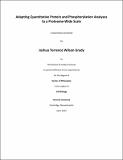| dc.contributor.advisor | Gygi, Steven P. | |
| dc.contributor.author | Grady, Joshua Terrence Wilson | |
| dc.date.accessioned | 2013-09-30T20:07:01Z | |
| dc.date.issued | 2013-09-30 | |
| dc.date.submitted | 2013 | |
| dc.identifier.citation | Grady, Joshua Terrence Wilson. 2013. Adapting Quantitative Protein and Phosphorylation Analyses to a Proteome-Wide Scale. Doctoral dissertation, Harvard University. | en_US |
| dc.identifier.other | http://dissertations.umi.com/gsas.harvard:10852 | en |
| dc.identifier.uri | http://nrs.harvard.edu/urn-3:HUL.InstRepos:11129110 | |
| dc.description.abstract | Liquid chromatography coupled tandem mass spectrometry (LC-MS/MS) has become the preferred method for large-scale peptide and phosphopeptide identification and quantification. The dominance of LC-MS/MS is the result of improved chromatographic, mass spectrometry and bioinformatic technologies. The applications of these technological improvements drive biological innovation by expanding the realm of possible experimentation, facilitating the creation and evaluation of novel hypotheses. Such improvements are the focus of this dissertation. New technologies are presented and their proteome wide applications in biological systems are demonstrated. A comparison of common phosphopeptide enrichment methods is presented in chapter two, which demonstrates that a combination of methods provides non-overlapping data sets. This comparison was performed in mitotically arrested fission yeast, a previously unstudied system by phosphoproteomic methods. This chapter remarks upon phosphorylation site conservation between lower and higher eukaryotes, as a means of predicting potentially relevant phosphorylation events in mammals. A new protocol for tissue based peptide quantification is presented in chapter three. The large-scale application of this method is detailed in a system of mouse liver phosphorylation, between fasted and re-fed states. The effect of peptide and protein level false discovery rates on the accuracy of phosphorylation site quantification is highlighted. This method is a cost-effective alternative to available techniques, such as metabolic labeling, and expands the application of proteomics to include larger animals. Finally, an in depth analysis of quantitative LC-MS/MS based multiplexing is the subject of the last chapter. New techniques for peptide pre-fractionation and ion quantification are discussed, which improve proteome coverage and quantitative accuracy. This proteome-wide multiplexing is applied to an analysis of the budding yeast environmental stress response. Applicable methods of data processing and a means of obtaining biologically relevant information out of multidimensional proteomic data sets are discussed. In all chapters, the data presented represent the largest analyses of their kind. This dissertation provides a solid guide for future proteome-wide studies, focused on the identification and quantification of peptides and their posttranslational modifications. | en_US |
| dc.language.iso | en_US | en_US |
| dash.license | LAA | |
| dc.subject | Cellular biology | en_US |
| dc.subject | Mass Spectrometry | en_US |
| dc.subject | Multiplexing | en_US |
| dc.subject | Phosphorylation | en_US |
| dc.subject | Proteomics | en_US |
| dc.subject | Quantitative | en_US |
| dc.title | Adapting Quantitative Protein and Phosphorylation Analyses to a Proteome-Wide Scale | en_US |
| dc.type | Thesis or Dissertation | en_US |
| dash.depositing.author | Grady, Joshua Terrence Wilson | |
| dc.date.available | 2013-09-30T20:07:01Z | |
| thesis.degree.date | 2013 | en_US |
| thesis.degree.discipline | Cell Biology | en_US |
| thesis.degree.grantor | Harvard University | en_US |
| thesis.degree.level | doctoral | en_US |
| thesis.degree.name | Ph.D. | en_US |
| dc.contributor.committeeMember | Harper, Wade | en_US |
| dc.contributor.committeeMember | Moazed, Danesh | en_US |
| dc.contributor.committeeMember | Haigis, Kevin | en_US |
| dc.contributor.committeeMember | Gerber, Scott | en_US |
| dash.contributor.affiliated | Wilson-Grady, Joshua | |


